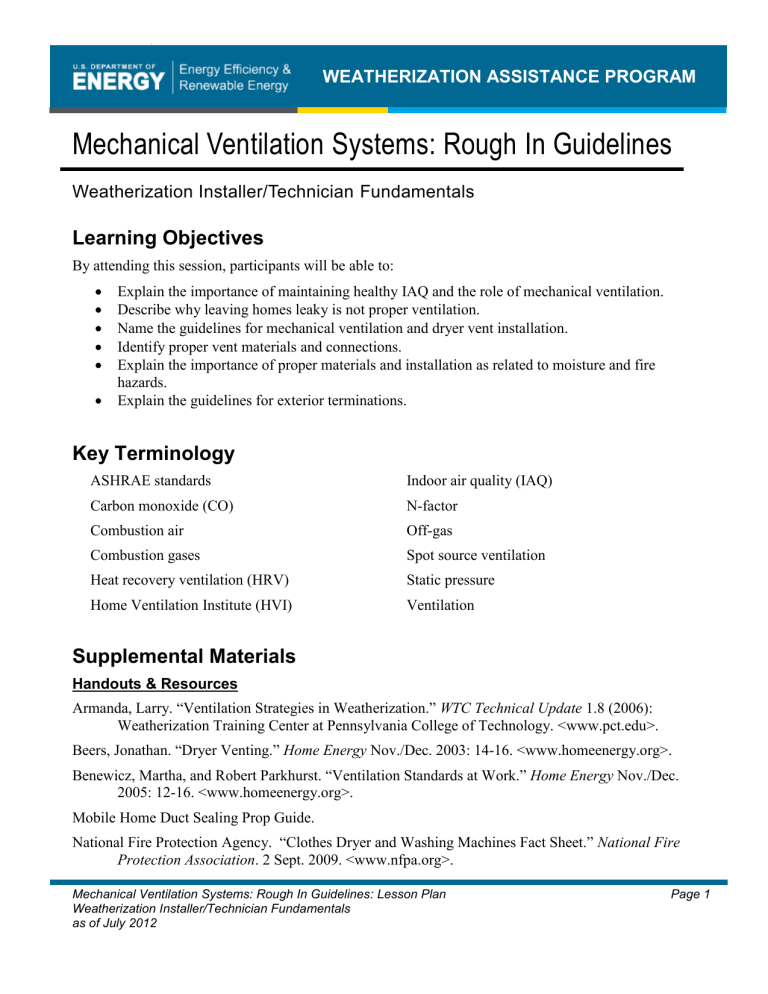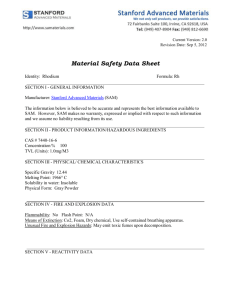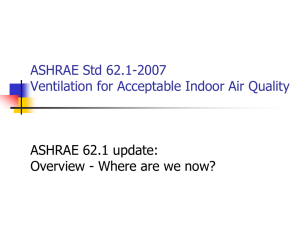Mechanical Ventilation Rough In Guidelines

WEATHERIZATION ASSISTANCE PROGRAM
Mechanical Ventilation Systems: Rough In Guidelines
Weatherization Installer/Technician Fundamentals
Learning Objectives
By attending this session, participants will be able to:
Explain the importance of maintaining healthy IAQ and the role of mechanical ventilation.
Describe why leaving homes leaky is not proper ventilation.
Name the guidelines for mechanical ventilation and dryer vent installation.
Identify proper vent materials and connections.
Explain the importance of proper materials and installation as related to moisture and fire hazards.
Explain the guidelines for exterior terminations.
Key Terminology
ASHRAE standards
Carbon monoxide (CO)
Combustion air
Combustion gases
Heat recovery ventilation (HRV)
Home Ventilation Institute (HVI)
Indoor air quality (IAQ)
N-factor
Off-gas
Spot source ventilation
Static pressure
Ventilation
Supplemental Materials
Handouts & Resources
Armanda, Larry. “Ventilation Strategies in Weatherization.”
WTC Technical Update 1.8 (2006):
Weatherization Training Center at Pennsylvania College of Technology. <www.pct.edu>.
Beers, Jonathan. “Dryer Venting.” Home Energy Nov./Dec. 2003: 14-16. <www.homeenergy.org>.
Benewicz, Martha, and Robert Parkhurst. “Ventilation Standards at Work.”
Home Energy Nov./Dec.
2005: 12-16. <www.homeenergy.org>.
Mobile Home Duct Sealing Prop Guide.
National Fire Protection Agency. “Clothes Dryer and Washing Machines Fact Sheet.”
National Fire
Protection Association . 2 Sept. 2009. <www.nfpa.org>.
Mechanical Ventilation Systems: Rough In Guidelines: Lesson Plan
Weatherization Installer/Technician Fundamentals as of July 2012
Page 1
WEATHERIZATION ASSISTANCE PROGRAM
National Fire Protection Agency. “Clothes Dryer Safety.”
National Fire Protection Association . 2
Sept. 2009. <www.nfpa.org>.
U.S. Department of Energy. Energy Efficiency and Renewable Energy. "Spot Ventilation Fact Sheet."
Various Ventilation Installation Instructions from Manufacturers.
Relevant Standard Work Specifications
6.6002 – Components
6.6004 – Appliance Exhaust Vents
6.9901.1 – Supplemental Ventilation Information – ASHRAE 62.2
Classroom Props & Activities
Assortment of bathroom fans, possibly removed from client homes
Various duct materials
Various dryer vent types
Two 2-liter bottles full of tap water
Various exterior exhaust hoods types
Two different sizes of cups
ACH Demonstration
Materials – Two 2-liter bottles full of tap water, two different sizes of cups, somewhere to dump water
Explain ACH and how it takes house size into account. Use the 2-liter bottles of water to represent how much air leaks through a house in one day. The different sizes of cups represent different sizes of homes. Pour water into the smaller cup, and then dump it out. Continue until one bottle is empty. Have students keep track of how many “air changes” the “small house” experiences, and then compare with the “large house” in the same way.
Hands-On Props and Activities
Duct Sealing Prop
Give students hands-on experience attaching, sealing, and insulating ducts with a simple duct prop.
Use the Mobile Home Duct Sealing Prop Guide for tools and materials lists, as well as photos of a sample prop. Discuss where and how ducts attach to various fans and appliances.
Terminations Activity
Using a mock-up of a typical exterior wall in the region, have students practice creating penetrations for dryer vents and other exhaust terminations. Install terminations while outlining guidelines covered in the presentation, including pest exclusion, moisture issues, etc.
Exhaust terminations must be located away from air inlets and operable windows. Specific distance requirements vary based on the appliance. Reference the most current ASHRAE 62.2 standard for
Page 2 Mechanical Ventilation Systems: Rough In Guidelines: Lesson Plan
Weatherization Installer/Technician Fundamentals as of July 2012
WEATHERIZATION ASSISTANCE PROGRAM
exhaust ventilation guidance. Reference the manufacturer’s instructions and current international residential code for other appliances.
For students with no prior construction experience, demonstrate safe use of hand and power tools.
Class Overview
Use the presentation to introduce the concepts of IAQ, static pressure, and ASHRAE guidelines. Discuss the causes of indoor air pollution, and stress the impacts poor venting can have on IAQ and personal safety. Pass sample materials around to keep students engaged.
Orally quiz students on proper duct installation methods.
Hand out manufacturer’s installation instructions for an exhaust fan, and show students where to find steps of installation and any warnings. Explain the importance of attaching directly to framing members or to blocking installed between framing members. Using the instructions, walk installers through how they would determine whether installation was complete before insulating an attic (e.g. examining vents and wiring, closing junction boxes and ensuring vents terminate outdoors).
Again, using sample manufacturer’s installation instructions, along with sample fans, show students where the equipment shut-offs are located on typical mechanical ventilation equipment for your area.
Mechanical Ventilation Systems: Rough In Guidelines: Lesson Plan
Weatherization Installer/Technician Fundamentals as of July 2012
Page 3








